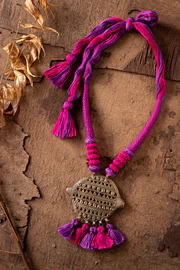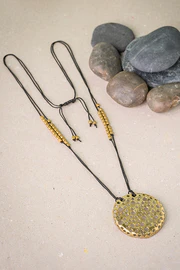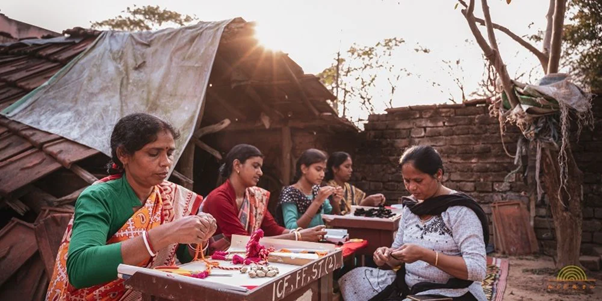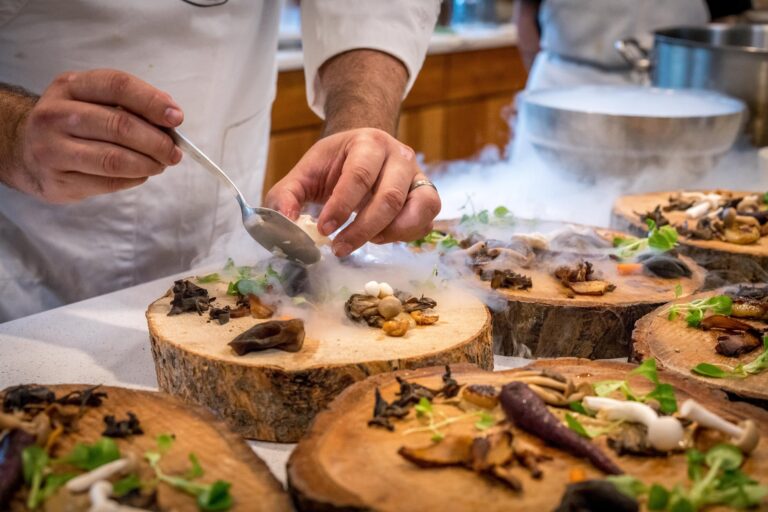Miharu is a cultural enterprise producing handmade accessories from the ancient crafts of Bengal. Inspired by the 4,000-year-old Dhokra Craft, Parul Bajoria started Miharu so everyone could appreciate its cultural heritage with a contemporary touch. Deriving motivation from this tribal craft still prevalent in her hometown Bankura, Parul put her designer hat on and successfully materialized her dream into an E-Commerce B2B enterprise. Apart from Dhokra based jewelry, their product line also includes Patwa designer ornaments and Baluchari sarees. They are also actively training women from rural Bengal to help them continue working on crafts and be financially independent.
Follow our conversation with her as she describes the learning curve she has encountered since she started her social venture.

Drawn to Dhokra craft: The inception of Miharu
Artisans in India create crafts with a lot of love and care. It compelled me to bring cultural art forms to the world for everyone to appreciate. After my first encounter with Dhokra, I was spell-bound by the craft’s simplicity and attention to detail. I am a mother of two daughters who wanted to make an impact in this industry, so I got in touch with a handful of artisans in my area.

The initial steps are crucial because you can’t just demand them to work for you in exchange for money. Unknown to many, craftsmanship does have its limitations:
The beauty of each piece of work stems from the freedom of design. It was a difficult task to give age-old techniques a contemporary touch. I slowly tried to bridge the gap between my designs and artisans to reach an equilibrium with the kind of products we manufactured.
From Dhokra to Patwa: Embracing time-honored craft
After launching Miharu, our primary focus has been on making products using Dhokra. Since our best-selling product line is jewelry, we decided to expand to other crafts like Patwa, a thread-based artform from Rajasthan.



Most of our customers are women who want to adorn jewelry that supports and appreciates these art practices. All of our products hint at modern fashion while preserving the timelessness of the craft. Products from our Modish Musings collection give the Dhokra craft a western touch.



Apart from jewelry, we also make home decor inspired by the lost-wax technique. Our line of Baluchari sarees – woven from pure silk – is yet another way to reflect on the intricate designs of rural crafts.
Social Media – A window to the world for smaller cities
Initially, I put up my business on Facebook, where I got great engagement. I have been in touch with a handful of people who were in the handicraft industry at the time. We are growing substantially on Instagram and Pinterest as well.
Since our business was promoting an ancient dying craft, many fashion influencers got in touch with us to collaborate and represent our brand. It was a fascinating experience to see them promote our jewelry to their followers. However, our business didn’t take a significant jump after these collaborations. This made me realize that promoting my idea through fashion influencers is insufficient. So we got in touch with various pages that supported Indian crafts and valued them. Whether writers, bloggers, or content creators, we looked beyond displaying our products as mere adornments.

The core motive of my business was to get people to admire crafts like Dhokra. I did not need to travel out of my town to put this out there. This is what makes social media special for me – I can sell my product from any corner of the world if I put my product on the internet in the right way. I encourage all cultural enterprises, be it from metropolitan cities or small towns, to use social media to grow their business. The ease of connecting with people on the internet is definitely a boon for businesses to flourish.

Challenges at inception – Learning from interactions
The birth of my idea lacked a team and a solid business plan. I knew I wanted to make a change in the handicraft industry, but I wasn’t sure how I was to bring this change. Gradually, my connections with artisans grew, and we managed to set up an E-commerce website. But there were a lot of concerns to be dealt with. For instance, safe shipping without breakage was one of our significant challenges. We tackled the shipping issue with our B2B model by channeling our products through brands like FabIndia.



Quality in Craftsmanship – Catering to Customers’ Desires
From my observation, customers look for quality in the products more than the design itself. Since all of our products are handmade, quality was a stumbling block. Homogeneity in design, quality, and the time taken to make the product is critical. Timely delivery was a crucial objective to keep our customers happy. It took time to convey this to our artisans and designers. We attained a middle-ground for contemporary design trends and manufacturing feasibility and created jewelry with effortless quality and design.
Connecting with NICEorg – Building an ecosystem for artisans
As it goes for any enterprise dealing with crafts, building a rapport with the artisans is a major obstacle. They are not keen on collaborating with just anyone on the internet. I believe that NICEorg can bridge this gap and allow brands like mine to connect with each other and help artisans interact with the world through us. It creates a vast ecosystem of like-minded entrepreneurs driven to get artisans comfortable with the outside world.

This will give them confidence in their work to go ahead and build a brand of their own someday.
Another critical side is financial literacy. Artisans can connect with financial experts and assist each other form sustainable enterprises. I am grateful to be part of this community, interact with fellow entrepreneurs, and thrive together with our artisans.
NICEorg wishes them the best of luck in their journey ahead!
If your cultural enterprise is in any of our five focus sectors and you would be interested in being featured, write to us at namaste@niceorg.in




